
Knox County is located in the U.S. state of Tennessee. As of the 2010 census, the population was 432,226, making it the third-most populous county in Tennessee. Its county seat is Knoxville, which is the third-most populous city in Tennessee.
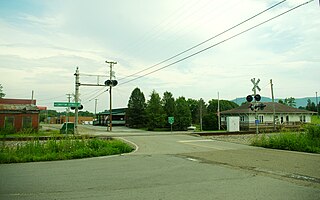
Corryton, also known as Corryton Village, is an unincorporated village and bedroom community in northeastern Knox County, Tennessee, United States, about 15 miles northeast of Knoxville. The United States Geographic Names System classifies Corryton as a populated place. It is included in Knoxville Metropolitan Statistical Area.

Sequoyah Hills is a neighborhood in Knoxville, Tennessee, United States. It is located off Kingston Pike between the city's downtown area and West Knoxville. Initially developed in the 1920s, Sequoyah Hills was one of Knoxville's first suburbs, and today is home to some of the city's most affluent residents. The neighborhood contains numerous notable examples of mid-20th century residential architecture, with houses designed by architects such as Charles I. Barber, Benjamin McMurry, and Francis Keally. Sequoyah Hills is named for the Cherokee scholar Sequoyah, inventor of the Cherokee alphabet.

The Ramsey House is a two-story stone house in Knox County, Tennessee, United States. Also known as Swan Pond, the house was constructed in 1797 by English architect Thomas Hope for Colonel Francis Alexander Ramsey (1764–1820), whose family operated a plantation at the site until the U.S. Civil War. In 1969, the house was added to the National Register of Historic Places for its architecture and its role in the region's early 19th-century history.

Statesview, or States View, is a historic house located on South Peters Road off Kingston Pike in Knoxville, Tennessee, United States. Built in 1805 by early Knoxville architect Thomas Hope and rebuilt in 1823 following a fire, Statesview was originally the home of surveyor Charles McClung (1761–1835). Following McClung's death, newspaper publisher Frederick Heiskell (1786–1882) purchased the house and estate, which he renamed "Fruit Hill." The house is listed on the National Register of Historic Places for its architecture and political significance.
This is a list of the National Register of Historic Places listings in Knox County, Tennessee.

The Knox County Courthouse is a historic building located at 300 Main Street in Knoxville, Tennessee, United States. Built in 1886, it served as Knox County's courthouse until the completion of the City-County Building in 1980, and continues to house offices for several county departments. John Sevier, Tennessee's first governor, is buried on the courthouse lawn. The courthouse is listed on the National Register of Historic Places for its architecture and its role in the county's political history.
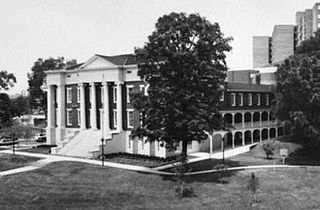
Old City Hall is a complex of historic buildings located at 601 West Summit Hill Drive in Knoxville, Tennessee, United States. Originally constructed in 1848 as the Tennessee School for the Deaf and Dumb, the complex served as Knoxville's city hall from 1925 until 1980. The complex has been listed on the National Register of Historic Places and has been documented by the Historic American Buildings Survey. It currently houses Lincoln Memorial University's Duncan School of Law.

Seven Islands Methodist Church is a historic church located near the south bank of the French Broad River in Knox County, Tennessee. The church building is listed on the National Register of Historic Places.
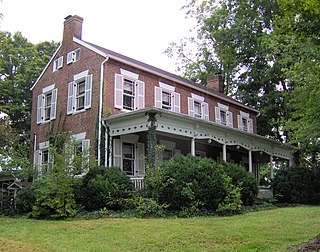
Wheatlands is an antebellum plantation in Sevier County, in the U.S. state of Tennessee. The plantation's surviving structures— which include the plantation house, a storage shed, and smokehouse— have been placed on the National Register of Historic Places. The plantation house has been called "the best example of a Federal-style building remaining in Sevier County."

The Middlebush Village Historic District is a historic district located in the Village of Middlebush, an unincorporated community within Franklin Township, Somerset County, New Jersey. The district was added to the National Register of Historic Places on April 24, 2007. It includes 37 contributing buildings and three contributing sites.
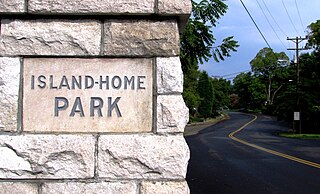
Island Home Park is a neighborhood in Knoxville, Tennessee, United States, located in the southeastern part of the city along the Tennessee River. Developed as a streetcar suburb in the early 1900s, the neighborhood retains most of its original houses and streetscapes, and is home to the city's largest concentration of Bungalow-style houses. In 1994, several dozen houses in Island Home Park were added to the National Register of Historic Places as the Island Home Park Historic District.
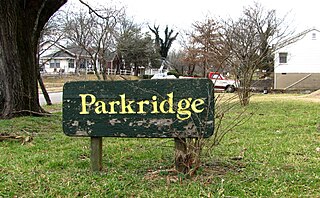
Parkridge is a neighborhood in Knoxville, Tennessee, United States, located off Magnolia Avenue east of the city's downtown area. Developed as a streetcar suburb for Knoxville's professional class in the 1890s, the neighborhood was incorporated as the separate city of Park City in 1907, and annexed by Knoxville in 1917. In the early 1900s, the neighborhood provided housing for workers at the nearby Standard Knitting Mills factory.
Thomas Hope was an English-born American architect and house joiner, active primarily in Knoxville, Tennessee, during the late eighteenth and early nineteenth centuries. Trained in London, Hope moved to Knoxville in 1795, where he designed and built several of the city's earliest houses. At least two houses built by Hope— the Ramsey House (1797) in East Knoxville and Statesview in West Knoxville— are still standing, and have been listed on the National Register of Historic Places.

James Gilbert Sterchi was an American businessman, best known as the cofounder and head of the furniture wholesaler, Sterchi Brothers Furniture Company. At its height, Sterchi Brothers was the world's largest furniture store chain, with sixty-five stores across the southeastern United States and a worldwide customer base. In 1946, the company became the first Knoxville-based firm to be listed on the New York Stock Exchange. The company's ten-story headquarters, now called Sterchi Lofts, stands prominently along Knoxville's skyline, and Sterchi's home in northern Knoxville, Stratford Mansion, is listed on the National Register of Historic Places.

Gay Street is a street in Knoxville, Tennessee, United States, that traverses the heart of the city's downtown area. Since its development in the 1790s, Gay Street has served as the city's principal financial and commercial thoroughfare, and has played a primary role in the city's historical and cultural development. The street contains Knoxville's largest office buildings and oldest commercial structures. Several buildings on Gay Street have been listed on the National Register of Historic Places.

The South Market Historic District is a cluster of five buildings at the intersection of Market Street and Church Avenue in Knoxville, Tennessee, United States, listed on the National Register of Historic Places in 1996. The buildings, which include the Cherokee Building, the Ely Building, the Cunningham, the Stuart, and the Cate, were built circa 1895—1907, and were used for both office space and residential space. Several prominent Knoxville physicians and three marble companies operated out of the buildings in this district in the early 1900s.

The Baumann family was a family of American architects who practiced in Knoxville, Tennessee, and the surrounding region, in the late 19th and early 20th centuries. It included Joseph F. Baumann (1844–1920), his brother, Albert B. Baumann, Sr. (1861–1942), and Albert's son, Albert B. Baumann, Jr. (1897–1952). Buildings designed by the Baumanns include the Mall Building (1875), the Church of the Immaculate Conception (1886), Minvilla (1913), the Andrew Johnson Building (1930), and the Knoxville Post Office (1934).

BarberMcMurry, formerly Barber & McMurry, is an architecture firm based in Knoxville, Tennessee, USA. Founded in 1915 by Charles Irving Barber (1887–1962) and Benjamin Franklin McMurry, Sr. (1885–1969), the firm designed dozens of notable houses, churches, schools, and public facilities in Knoxville and the surrounding region in the early 20th century, several of which have been listed on the National Register of Historic Places. In recent decades, the firm has expanded its focus to include larger-scale projects, such as hospitals, stadiums and retail complexes.
Charles Ives Barber was an American architect, active primarily in Knoxville, Tennessee, and vicinity, during the first half of the 20th century. He was cofounder of the firm, Barber & McMurry, through which he designed or codesigned buildings such as the Church Street Methodist Episcopal Church, South, the General Building, and the Knoxville YMCA, as well as several campus buildings for the University of Tennessee and numerous elaborate houses in West Knoxville. Several buildings designed by Barber have been listed on the National Register of Historic Places.
















